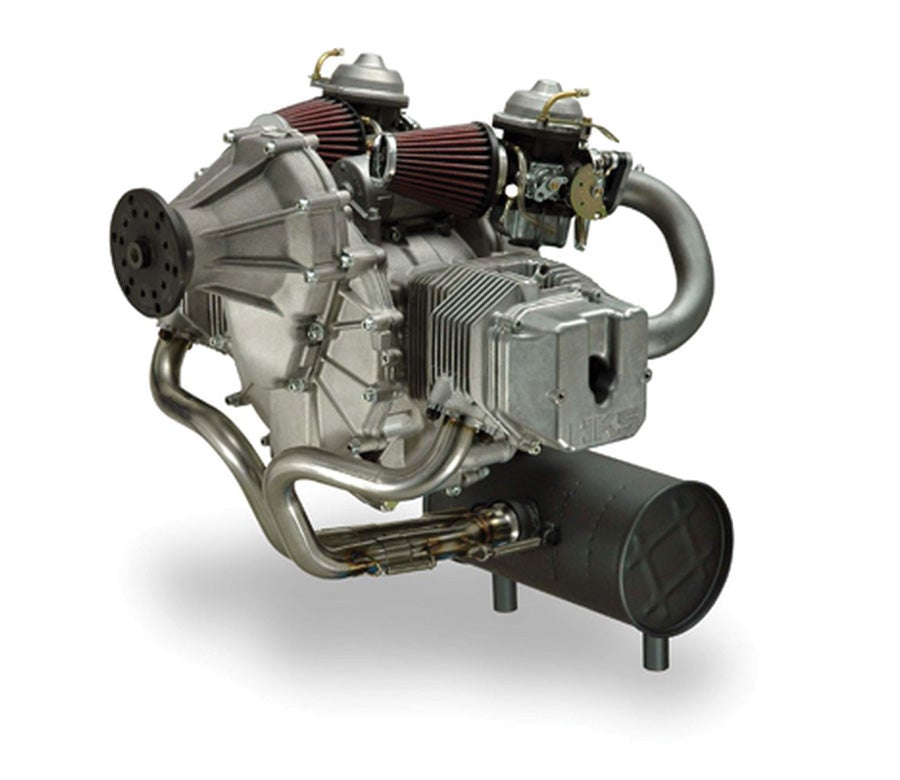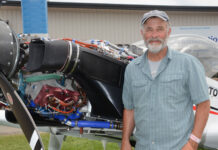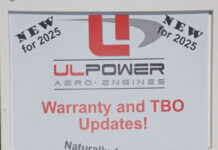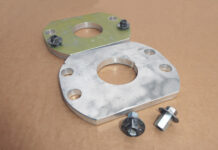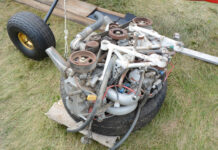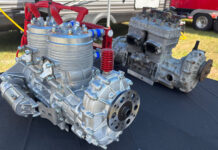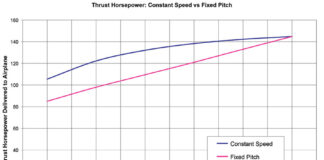For pilots, few choices are more visceral than engine preference. A whole spectrum of human emotions can play a role. There is, for example, nostalgia. Who doesn’t love the look of a radial, or the sound of a Merlin? No one will question your choice, as long as it drips as much romance as it does oil. There is familiarity, which offers personal comfort with a dividend of good, as it tends to result in correct installation and operation. There is pride, which does not always go before a fall; pride often leads to premium choices and better care, and aviation tends to reward the best. To be honest, there is even a fear factor. An engine failure at the wrong moment can result in death, a fact all pilots recognize, even as they lock it away in the part of the brain labeled “To Be Ignored.”
It’s said that aircraft design is the art of considered compromise. If so, any change to a really optimized design will require a tradeoff somewhere else. Many experienced builders stay close to the designer’s intent, having learned that lesson the hard way. For those builders, the engine choice was made when they bought the airframe kit.
For others, powerplant creativity is a passion. There are no hard limits except the laws of physics. Size, weight, and thrust must be suitable, but beyond those factors the field is open. The key is to carefully weigh the compromises, exactly like the skilled airframe designer.
The Rational Three
Begin by carefully considering the primary mission. A Van’s RV-10, for example, is fundamentally a people hauler, and those people are often very dear. Given the mission, a reasoned compromise may prioritize reliability above all else, with perhaps longevity and cruise economy as the second and third factors. A plansbuilt Pitts is a different animal. A highly modified engine may come with an increased risk of catastrophic failure, but it’s a reasoned compromise given the mission. A Model A Ford is perfect for an old-school Pietenpol. The mission is to recreate the past, and fly gentle laps around a grass field on a beautiful evening.
Dirty Harry had it right; a man should know his limitations. At some point you’ll need to understand everything about the installation, and that often means learning as you go. Be realistic. Are you willing to do the technical research necessary to support the kind of engine you choose? Installing a box-stock O-320 with mags is easy, and there are legions of builder friends who can help. At the other end of the scale, truly engineering your own propeller speed reduction unit and installing it on the engine of your dreams may require the equivalent of a master’s degree. That doesn’t make it a bad choice. Certainly there is merit in self-education, and honestly, some like the design challenge as much as they like flying the result. Think about what you really like.
Last, hedge your bets by becoming a skeptic. Don’t believe half the claims, and carefully confirm the other half. The courts have a term for an expansive claim that is not quite true, but not quite false. It’s called “puffery,” and there’s enough of it in sport aviation to fill fleets of hot-air balloons. The law allows puffery on the grounds that no thinking person would consider the claim literally true…yet it can be hard to resist. Well, lock away your credit cards until you measure the claim against fundamental physics. Search the online forums. Go to the fly-ins and ask the other builders. You’ll probably hear a few interesting stories, make a few new friends, and avoid a bad choice or two.
On With The Show
Ladies and gentlemen, right this way please. It’s time for the 2016 Engine Buyer’s Guide…but first, a few rules.
The Guide is limited to engines available now or in the near future, as complete units marketed to the Experimental community. We’ve skipped engines marketed as “certified only,” and those deemed impractical or unavailable (“What, what, old man…no Armstrong Siddeley Boarhound?”). Along the same lines, we can’t list every engine model offered by the majors. If you insist on installing the TIO-541-E1C4, usually seen on a Beech Duke, try any Lycoming phone number. They will be happy to take your order, with or without a listing here.
You’ll find engines sorted by configuration or family, not the traditional “aircraft engine” and “alternative engine” labels. Frankly, the line has begun to blur. We’ll carefully describe each as we go, and assume our readers are smart enough to know (for example) that a Corvair was a car.
We found a huge variety of small engines in the marketplace. However, many of them are not big enough to power a typical homebuilt. Here we drew an arbitrary line at roughly 50 horsepower. Some of the listed manufacturers sell smaller engines too…call them.
Prices and weights are supplied by the vendor. Some prices are MSRP, and others may be a street price. Quotes to us in euros and other currencies were converted to U.S. dollars using exchange rates in effect at press time, and are subject to change. All prices are for assembled engines unless marked “kit.” We’ve tried to determine what accessories are included at a given price and weight, but all the possible combinations make our eyeballs spin. Trust, but verify!
The Engine Guide is a source of basic information. It is not an endorsement. Here at KITPLANES we have opinions, just like everyone else, but in the Guide we make no judgments. You’re an aircraft builder, so please, do your homework.
Flat Four Stroke
Lycoming sells stock engines via distributors, and custom engines via its own Thunderbolt sales channel. A very high percentage of the non-certified models are sold by one distributor, Van’s Aircraft, but those sales are restricted to purchasers of a Van’s airframe kit. Other kit suppliers may have similar arrangements. Thunderbolt is the factory-direct route, mild or wild. According to Thunderbolt’s Dennis Coulbourn, all engines built at the Advanced Technology Center are assembled by two-man teams assigned one engine at a time, rather than by the traditional assembly line method. All are internally balanced to within 1/2 gram and get special attention to airflow, improvements typical of custom engine shop work. A purchaser may specify most accessories, while internal parts are limited to combinations available from the standard Lycoming parts bin.
Contrary to all others listed here, Lycoming declined to quote base prices for any of its non-certified engines, stock or via the Thunderbolt channel. Rather than leave the spaces blank, we’ve listed prices from the Van’s catalog as representative of what a buyer might expect to pay for a standard engine in a competitive marketplace. We have no idea what the Thunderbolt version of the same engine might cost; interested builders will be required to call for a quote.
Continental Motors has continued its march toward becoming a universal supplier of general aviation engines. In addition to its traditional avgas-fueled offerings, Continental has rapidly become the largest GA supplier of diesel powerplants, and now they build and sell what might be impolitely called a Lycoming clone.
First, the traditional. Continental’s O-200-D4B is the lightweight version of the classic O-200A, and both remain popular on Cub-class airframes. The IO-240 boosts hp for larger airframes. The middle hp range (150-220) has tended to be a held by others (until recently, see below), but Lancair owners in particular love the IO-550 and TSIO-550 models. And not without reason; a Legacy is all about speed, and Continental power continues to fill the Reno Sport-class Gold ranks year after year.
Continental Diesel has been busy on the certified side, but it wasn’t until recently that one of Continental’s aero-diesels reached the E/A-B market in a Glasair Sportsman. As of press time, it is not possible to purchase the CD-155 4-cylinder turbo-diesel for installation in the homebuilt of your choice. Even Glasair requires that Sportsman Diesel builders use the Two-Weeks-to-Taxi program. The concern is that installation of the new engine, being liquid cooled, geared, turbocharged, and FADEC controlled, may exceed the capabilities of the average homebuilder. True or not, for now the CD-155 is only available in a supervised build program, or not at all. Diesel pricing is included in a complete firewall-forward package from Glasair.
2015’s most surprising engine news was Continental’s purchase of Engine Components International (ECI) from Danbury Aerospace, along with all its companion business units. Included in that purchase was the Titan engine brand, a popular source of non-certified propulsion for kit aircraft. Right from the start, Continental offered no confusion about their intent. Quoting from the press release, the purchase allows Continental to “offer new products and service in the kit market, Experimental market, and certified aftermarket.” Translation? Continental now builds a complete line of Lycoming-pattern engines for kit aircraft (a market where they have been running back in the pack), as well as a line of PMA parts for certified Lycomings…all while eliminating a PMA parts competitor for their traditional product.
Ahh, yes, the engines. At press time, ECI has become Continental Motors San Antonio, although the Titan name may stay awhile. In addition to the usual carbureted or fuel injected 320 and 360 engines, Titan also offers the lightweight Stroker 340, well known as the power behind the Carbon Cub’s performance. A 370 is also available, injected or carbed, and now (drum roll please) with a pendulum crank for long-term vibratory happiness. In addition, they now have front-governor cases, and expect to offer roller lifters very soon.
The big deal? It’s the Titan 540 six-cylinder. Until now, the choice has been between a new Lycoming 540 or a rebuild, and rebuild parts were expensive. The Titan 540 can be ordered with 8.5 or 9.1 compression, and like the other Titan models, can be optioned with a wide variety of accessories.
It’s worth noting that Titan engines currently come with a 3-year/2000 hour warranty, beginning at first operation or one year from delivery, whichever comes first. That’s longer than the other players, and a pretty good deal for homebuilders.
Rounding out the Big Three, Rotax has announced development of a new model, the turbocharged, intercooled, and fuel injected 915iS. At a rated 135 hp, it will be the most powerful Rotax yet. Final specifications and price were not available at press time; production is expected sometime in 2017.
Last year the fuel-injected 912iS received further development, primarily to produce more power in the range between 4500 and 5000 rpm. In a gesture much appreciated by customers, early 912iS models were updated at no charge (hard parts, software, and labor), assuming the work was performed at an authorized service center.
The classic 80-, 100-, and turbocharged 115-hp 912 models continue to sell well, as does the last remaining two-stroke in the Rotax aviation line, the water-cooled 582UL. Rotax is the unquestioned front-runner in this horsepower segment, having sold over 50,000 9-series four-strokes, and more than 30,000 582s.
Superior Air Parts opened 2015 with a splash announcement of the new Gemini Diesel series. It’s a fascinating layout; opposed piston pairs share a common combustion chamber in the center of a water-cooled mono-block, and drive a pair of geared crankshafts located where we normally expect to find cylinder heads. It’s a two-stroke, so a supercharger is required to fill the cylinder; higher horsepower versions are also expected to require a turbocharger. The first model is intended as a practical alternative to the Rotax 912ULS; same 100-hp rating and overall physical footprint, but with a much lower fuel burn. Superior is talking about future models up to 550 hp, and apparently they have the investor money and worldview to make it happen. Stay tuned, as this could get interesting.
Closer to home, Superior’s XP-Series four-cylinder lineup continues to be very popular with kit builders interested in a Lycoming-style engine. A flinty-eyed look at the standard equipment list finds roller lifters and Precision EX-5 fuel injection standard on all models. The stroked XP-382 and the big bore XP-400 come standard with pendulum absorber cranks (often called “counterweights,” although they counterweight nothing but themselves), the result being fewer concerns with propeller selection. Superior runs a popular build school, which means a buyer has four purchase options. He (or she) can travel to Coppell, Texas, to assemble the engine themselves, under the supervision of factory technicians. Those less inclined to turn wrenches can visit, attend an engine-training course, then watch their engine being assembled at the Build Center. Options three and four are conventional; simply order a complete engine built in-house, or buy from your favorite custom engine shop, and Superior will cheerfully deliver a full parts kit to them for assembly. In-house or out, a buyer has his choice of accessory options.
Advanced Component Engineering (ACE) is a showcase for new thinking from Andrew Higgs, an engine design specialist based in Japan. His signature component is the ACE monolithic cylinder assembly, a one-piece aluminum head and barrel with a pressed-in hypereutectic liner. The combustion chamber has generous squish areas for centralized, turbulent combustion, the result being increased detonation margin. Looking ahead to more advanced electronic controls, the exterior is drilled for a knock sensor as well as the usual CHT probe. ACE has also introduced lightweight connecting rods and pistons based on the best current engine design practice, a new counterweighted crankshaft, and has shown at least two interesting intake plenums.
The first component sets went on new engines during a short-lived arrangement with Titan. ACE partner Kevin Eldredge has since set up an independent shop in San Luis Obisbo, California. At press time he reported finalizing arrangements that will allow him to build future engines on new cases and other parts sourced from Lycoming, meaning ACE purchasers will have the choice of an entirely new assembly, or an upgrade on an existing engine.
Franklin engine owners may be among the world’s most patient people. The Franklin design rights went to Poland 40 years ago, and owners still await the return of steady production and parts supply. The rights are currently held by a Polish private firm, Franklin Aircraft Engines Sp, who doesn’t seem to turn out very much. The Franklin world continues to wait.
In the meantime, there appears to be at least two sources of new engines, or rather, engines made from collected stocks of original and PMA parts. Franklin Aerospace and engine shop partner Southern Aero, both of Thomasville NC, can supply a 4A-235, complete with starter, alternator, and carb or Rotec injector, with choice of conical or bed mounts. Long term stalwart Susan Prall of Franklin Engine Company, in Jewitt, TX, should be able to do something similar.
ULPower is attracting a lot of attention with a full line of four- and six-cylinder models. Last year at Sun ‘n Fun, the company dismantled one for visitors to view, with ULPower’s chief engineer on hand from Belgium to answer questions. U.S. representative Robert Helms, in an Oshkosh presentation, reported over 550 units sold worldwide, with over 150 in the USA. The CNC’d components are beautiful, and all models include electronic ignition and port fuel injection. ULPower is the only new-wave manufacturer offering lightweight air-cooled engines in the 180- to 200-hp range, and as such, they bear watching.
Jabiru pioneered the new wave more than 20 years ago. 2015 was an unhappy time, as Jabiru owners in the home country (Australia) were forced to operate under a CASA-imposed requirement to inform passengers, in writing, that the engine has “suffered a high number of failures and reliability problems.” CASA published reliability statistics to back their action. The Australian Recreational Aviation Association acknowledged the reliability issue, but disputed CASA’s statistical methods, and objected to their approach, in particular the condemnation of a brand rather than the correction of specific issues. Not surprisingly, Jabiru considers the requirement to be draconian, while insiders whisper about personality clashes. Worldwide, no other regulatory agency has found reason for concern.
Adding fuel to the fire, CAMit Aero Engines entered the market. According to US distributor Jack Gonzenbach, CAMit Pty Ltd was the original contract machining facility for Jabiru engine parts. When Jabiru elected to move some operations elsewhere, CAMit’s principals felt it was time to offer their version, with improvements.
MW Fly Aero Power is offering a total of six models intended for fixed wing flight, in two displacements, with direct drive or one of two reduction ratios. The ratios allow increased rpm for more horsepower, while swinging larger-diameter propellers. The engines are technically interesting: water cooled, fuel injected, dual ignition, dual FADEC with data export, and automatic compression release for low rpm vibration control. The web site includes an excellent photo tour of the engine internals.
D-Motor offers a clean-sheet design notable because it is a water-cooled flathead. Although flathead valve-in-block designs are most often associated with lawnmowers and pre-WW-II Fords, the layout is a perfectly reasonable pick for a small aviation engine. The key points are simplicity and low parts count, good for reliability; a small width dimension, resulting in low frontal area; and less weight, which is always welcome. EFI and dual ignition are standard, with redundant control functions, and the 4-cylinder is now ASTM compliant.
The light aircraft world almost lost a good engine, but thanks to the efforts of two dedicated dealers, the Japanese HKS opposed twin remains in production. Jerry Olenik of Green Sky Adventures and Chris Hatin of Quicksilver Aircraft Northeast teamed up to make it happen, and are now the worldwide distributors. In addition to the familiar 700E, a new high-output twin is on the way, with more displacement and sequential fuel injection.
Hexadyne bills the P60 Twin as “The Lightweight Champ,” and at less than 100 pounds, they could be right. Although there are some additional parts to buy, the P60 also appears to be the price leader in this segment. Fuel injection, electronic ignition, and a starter are included.
The last entry in this category should be a big favorite with traditionalists. It’s the Pegasus Power DP-1, fundamentally one-half of a Continental O-200. The current business plan supplies the necessary components as a kit. The rest of the engine is built using standard Continental parts, OEM, PMA, or used. The key Pegasus components are a new 2-cylinder engine case and crankshaft, plus new, lighter connecting rods and pistons for better reciprocating balance. The first delivery is expected at the Sport Aviation Expo.
Inline and V Engines
Traditionalists will also be glad to hear that Czech-made LOM inline engines are still in production, and the company is actively looking for a new U.S. importer. For now, the factory can offer any one of five models on a direct basis, including a new lightweight version.
At the other end of the scale we have ADAPT Airmotive, an entirely non-traditional geared V-6, available normally aspirated or turbocharged. The V layout is a flat 120 degrees, so the profile fits nicely in a conventional cowl, and the clean-sheet design incorporates every feature in the modern design book. The company has been flying test engines since the summer of 2010, and is now taking reservations for production slots.
If you like Detroit V-8s, consider the next three entries. First up we have Robinson V-8 Power. Although best known as a replacement package for aging Franklins in Seabee amphibians, the experience gained transfers nicely, and the company is happy to engineer a similar LS-3 or LS-7 Chevy package for any aircraft. The Robinson PSRU is based on a Morse Hi-Vo chain.
AutoPSRU’s of Fort Worth, Texas is the new home of the centrifugal clutch driven PSRU formerly offered by the late Bud Warren. Owner Stuart Davis is supporting Warren’s legacy owners, making a few modest changes, and developing additional applications. Davis likes the LS-3, but has also adapted the Chevy-sized spur gear PSRU to a Subaru.
Our third player, Firewall Forward Aero Engines, currently offers two engines, large and small. Their well-developed Chevy LS-3 based package comes with a spur gear PSRU and dual accessory drives. They’ve also been building their 1590cc Honda Civic-based package for almost 20 years. It’s rated at 125 hp, with variable valve timing and EFI.
AeroMomentum has attracted a lot of attention with its low profile, 70-degree-slant, geared engines. The four available packages are Suzuki based, but company principal Mark Kettering says they now source blocks directly from the original casting company, and build entirely new engines in-house using a combination of OEM and custom components. Kettering is a qualified engineer, and did torsional vibration modeling as part of the initial design process. The first production units were sold and flogged in the airboat market for two years prior to any aviation use.
Raven Re-Drives recently introduced a new Honda package to replace the successful Suzukis they’ve been selling since the 1990s. The upright Raven STOL Max 1500XV is built around the L15A Jazz/Fit motor available worldwide. The key feature of founder Jeron Smith’s belt re-drive design has always been the clever use of a friction-based true damper in parallel with a soft element, all encased within the upper sprocket. It’s a clever solution to torsional vibration, taken straight from the textbooks.
Jan Eggenfellner’s Viking Aircraft Engines continues to offer a very complete package based on the 1.5L Honda Fit. Using a number of custom components, the block is rolled so the bores are horizontal, creating a low profile suitable for conventional cowlings. Power is transferred to the geared PSRU via a rubber torsional coupling tailored to the application. The latest engines are GDI (gasoline direct injection) and are rated at 130 hp in Viking trim.
Last in this group we have the Valley Engineering Big Twin. Gene and Larry Smith have long been the unsung heros of low-budget flyers everywhere, and the Big Twin carries on that tradition. The core Generac stationary engine is coupled with the ultra-simple Valley PSRU pioneered on VW conversions, and the resulting Big Bad Twin swings a 6-foot prop with ease, on not much more than 2 gallons an hour. The package has been around since 2006, when it won an innovation award at Oshkosh.
Four-Stroke Radials
The supercharged 9-cylinder Vedeneyev M-14 appears to be out of production in Mother Russia, but George Coy’s Motorstar NA can still get a new one from the Romanian facility, which recently made a batch for a military client. Remanufactured engines continue to be available from a number of sources, imported and domestic. Motorstar is also following the development of a new 7-cylinder Russian radial of just under 35 inches diameter. It’s currently called a “Rhythm.” We think George secretly hopes it will someday turn into a 14-cylinder double row. Stay tuned; the 7-cylinder is promised for 2016.
Sport aviation’s most popular radials are, hands down, the Rotec R2800 and R3600. They’re price competitive with new flat engines, their size and weight footprint makes them perfect for homebuilts and replicas, and they fascinate everybody who sees one. At press time, the Chernikeeff brothers of Oz had delivered more than 1600 units to the U.S. alone. By the way, the price listed in the Guide includes shipping to the U.S., and the parts warranty is 10 years.
Verner Motor, the Czech-based engine shop previously known as a supplier of converted BMW twins, has developed a line of three-, five-, and seven-cylinder radials. There are actually two 7-cylinder models. The larger is about the same diameter as the smaller Rotec (both a tad under 32 inches in diameter), but with less weight, being direct drive rather than geared. The smaller 7-cyl, 5-cyl and 3-cyl engines don’t directly compete, and should considerably expand the range of airframes suitable for the delights of radial power.
Rotary (Wankel)
It would appear that the only remaining source for a complete rotary power aviation package is American Rotary Engine. Dave Atkins tells us he can still supply a fresh Mazda, coupled to a Powersports PSRU, by special order. Mazda hasn’t built any rotaries since 2012, but there is no long-term supply concern at ARE, as a companion business under the same roof maintains the world’s largest independent inventory of rotary engine parts.
Compression Ignition, Diesel/Jet-A
We’ve previously discussed Continental and Superior, major 100LL players with a branch commitment to diesel. For others, diesel engines are the only game in town. The most developed is probably the French SMA SR305-230E, a 230-hp turbocharged, air-cooled flat four that mimics the form factor of conventional gasoline engines. At 450 pounds, it’s heavier than a traditional 260-hp gas 6-cyl, but not so much that adapting it to an IO-540- or IO-550-sized airplane is impossible. The real issue for a homebuilder is that SMA has, oddly enough, chosen to follow Continental’s lead and offer the engine only through a kit manufacturer’s supervised build program. At press time, we’re not aware of an SMA-linked kit program, but there is probably one under discussion somewhere.
2015 brought new funding to Wisconsin’s DeltaHawk, who tells us they are on track for FAA certification, hopefully by AirVenture. At 315 pounds, the DH180A4 is a wee bit heavier than competitive diesels and 180-hp gas engines. However, it was designed around old-school pump injection, and thus doesn’t require the weight of redundant electrical systems to drive computerized fuel controls. DeltaHawk has plans to market directly to homebuilders via packaged firewall-forward kits, which is welcome news for old-school builders.
Wisconsin’s other entry is the rapidly developing EPS Aero. More formally known as Engineered Propulsion Systems, the company intends to push their Graflight V-8 through FAA certification sometime in 2016. The package is state of the art, and the development team includes some very major players at both the corporate and personal levels. Our crystal ball says the Graflight V-8 may ultimately be too expensive for much of the homebuilt community, but it will be interesting to watch.
At the other end of the price spectrum, consider the FlyEco. Based on the 3-cylinder Mercedes turbodiesel found in European Smart cars, it is rated at 80 hp and weighs less than a standard O-200. FlyEco showed the engine at Aero Friedrichshafen, with a price of 19,800 euros. There is currently no word on when (or if) we can expect the FlyEco diesel outside Europe.
Volkswagen
Things are as busy as ever in the VW world. AeroVee branded engine kits from Aero Conversions (aka Sonex) are available in 80-hp NA (naturally aspirated) and 100-hp turbocharged versions. Kits include everything needed to roll your own 2.1L flat four, with dual ignition, a starter, a built-in alternator, and an AeroInjector to flow the fuel.
Great Plains Aircraft Supply engine kits allow a builder to configure a VW exactly as desired for any application, by choosing a traditional prop hub location on the crank nose, a prop hub driven from the flywheel end, or a belt reduction. There are four different displacements available, and the range extends up to 105 hp without a turbo.
Revmaster Aviation holds the line with a single 2331c model called the R2300, available NA or turbocharged. It is delivered fully assembled, ready to install, with a forged crank, dual CDI ignition, dual alternators, a large oil cooler, and a RevFlow carb. Founder Joe Horvath arguably knows more about air-cooled VW engines than anyone on earth.
Bush King Performance offers 2.1L and 2.3L engines with their own belt reduction. The idea is to swing larger props for maximum low-speed thrust. Both models are standard with electronic multi-port fuel injection, something rarely seen on an aviation VW. The package price includes the EFI, a starter, an alternator, the ignition, and a propeller.
Last, but not least, Hummel Engines specializes in simpler, lighter VWs. Scott Casler’s offerings actually start with cut-case twin-cylinder engines of 32 hp, priced at what seems like beer money to buyers hardened to aviation prices. The typical 4-cylinder Hummel is a hand-propped lightweight at about 20 pounds under the pushbutton variety, and arrives fully assembled and tested for less money than the average kit engine.
Corvair
Can there be anyone who hasn’t heard of William Wynne? Over a 27-year period, Wynne has developed his FlyCorvair enterprise into the respected source for Corvair knowledge, parts, and engines. The guy really, truly likes educating builders, and seems just as happy to see them learning to build their own at his Corvair College gatherings, as he is to take a check for a complete engine. We can’t possibly match the 2000 or more pages of information at the two FlyCorvair web sites, so, well…go there!
Another interesting Corvair source is Azalea Aviation. Owner Bill Clapp has developed his own front support housing and matching crankshaft modification, and offers complete engines as well as short blocks, reconditioned heads, conversion parts, and firewall forward accessory kits for about a dozen designs.
Jets
Right now there is only one small, ready-to-install, new jet engine for homebuilders, the TJ100 from PBS in the Czech Republic. Its best known application is currently the SubSonex single-seat fun jet. PBS builds the same core engine in turboshaft and turboprop versions, so it’s probably just a matter of time before some enterprising designer incorporates one into a kit.
Two-Stroke
The Rotax 582UL is the lone survivor of what was once a very popular lineup. Most long-term flyers of light aircraft think of the 582 as a third, much-improved revision of a water-cooled series that began way back in the ultralight-crazed ’80s with the 532. When installed and operated by the book, the Blue Head is very reliable, and leads the pack in price vs. hp.
The full line of Hirth two-strokes are distributed in North America by Recreational Power Engineering and its 45 or so dealers scattered across the continent. The line starts as small as 15 hp; here we’ve listed only the nine available models at 50 hp or more. The 50-hp F23 is unique; it’s a free-air-cooled opposed twin with a reduction drive, and only weighs 71 pounds with a recoil starter. We also find the 3502 inline twin and 3702 inline triple noteworthy, in that they are tuned for maximum power at less than 5000 rpm.
Two-stroke fans will enjoy visiting the Compact Radial Engines web site just to look at the wondrous variety. There are singles, twins, and yes, both a 3-cylinder and a 4-cylinder radial two-stroke. Only two of the line exceed 50 hp, a fan-cooled twin and a fan-cooled triple, both quite light for their horsepower.
Our final player is Simonini Racing, from Italy. Imported by Simonini USA, these engines appear to offer the highest power-to-weight ratio of all aviation two-strokes. The three Victor 2 models are identical, except for progressively more aggressive porting to boost horsepower. All are available with a wide variety of reduction ratios.
And so, that’s it until next year. We hope you enjoyed the tour. If you’re aware of an error, an omission, or something new, please bring it to our attention and we’ll correct the next Guide. Until then, shop wisely, install carefully, do the maintenance, and enjoy the flight.













